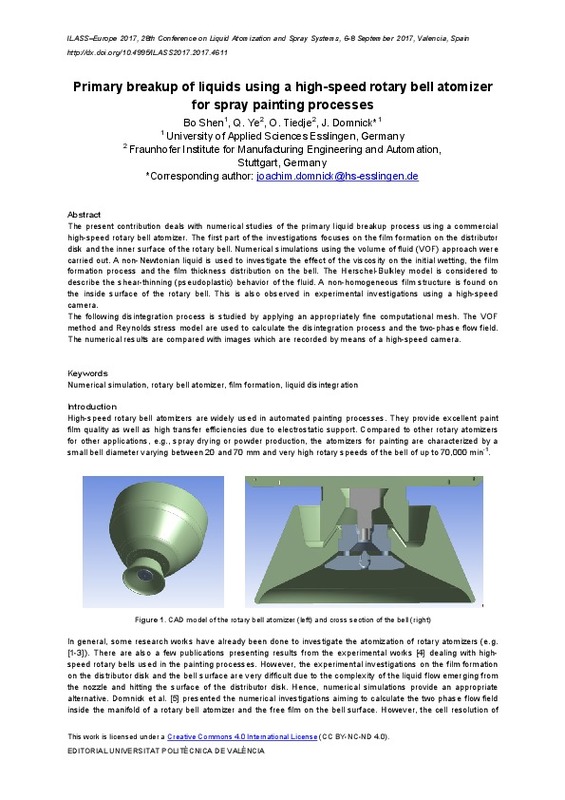JavaScript is disabled for your browser. Some features of this site may not work without it.
Buscar en RiuNet
Listar
Mi cuenta
Estadísticas
Ayuda RiuNet
Admin. UPV
Primary breakup of liquids using a high-speed rotary bell atomizer for spray painting processes
Mostrar el registro sencillo del ítem
Ficheros en el ítem
| dc.contributor.author | Shen, Bo
|
es_ES |
| dc.contributor.author | Ye, Qiaoyan
|
es_ES |
| dc.contributor.author | Tiedje, Oliver
|
es_ES |
| dc.contributor.author | Domnick, Joachim
|
es_ES |
| dc.date.accessioned | 2018-03-28T11:38:33Z | |
| dc.date.available | 2018-03-28T11:38:33Z | |
| dc.date.issued | 2017-07-28 | |
| dc.identifier.isbn | 9788490485804 | |
| dc.identifier.uri | http://hdl.handle.net/10251/99856 | |
| dc.description.abstract | [EN] The present contribution deals with numerical studies of the primary liquid breakup process using a commercial high-speed rotary bell atomizer. The first part of the investigations focuses on the film formation on the distributor disk and the inner surface of the rotary bell. Numerical simulations using the volume of fluid (VOF) approach were carried out. A non-Newtonian liquid is used to investigate the effect of the viscosity on the initial wetting, the film formation process and the film thickness distribution on the bell. The Herschel-Bulkley model is considered to describe the shear-thinning (pseudoplastic) behavior of the fluid. A non-homogeneous film structure is found on the inside surface of the rotary bell. This is also observed in experimental investigations using a high-speed camera. The following disintegration process is studied by applying an appropriately fine computational mesh. The VOF method and Reynolds stress model are used to calculate the disintegration process and the two-phase flow field. The numerical results are compared with images which are recorded by means of a high-speed camera. | es_ES |
| dc.description.sponsorship | The present investigations were supported by AiF Arbeitsgemeinschaft industrieller Forschungsvereinigungen. We thank our colleagues from the Fraunhofer Institute for Manufacturing Engineering and Automation in Stuttgart who provided the results from the experimental work that greatly assisted the present research. We also thank Anyang Wang for his assistance in producing the results used in this paper. | es_ES |
| dc.format.extent | 7 | es_ES |
| dc.language | Inglés | es_ES |
| dc.publisher | Editorial Universitat Politècnica de València | es_ES |
| dc.relation.ispartof | Ilass Europe. 28th european conference on Liquid Atomization and Spray Systems | es_ES |
| dc.rights | Reconocimiento - No comercial - Sin obra derivada (by-nc-nd) | es_ES |
| dc.subject | Numerical simulation | es_ES |
| dc.subject | Rotary bell atomizer | es_ES |
| dc.subject | Film formation | es_ES |
| dc.subject | Liquid disintegration | es_ES |
| dc.title | Primary breakup of liquids using a high-speed rotary bell atomizer for spray painting processes | es_ES |
| dc.type | Capítulo de libro | es_ES |
| dc.type | Comunicación en congreso | es_ES |
| dc.identifier.doi | 10.4995/ILASS2017.2017.4611 | |
| dc.rights.accessRights | Abierto | es_ES |
| dc.description.bibliographicCitation | Shen, B.; Ye, Q.; Tiedje, O.; Domnick, J. (2017). Primary breakup of liquids using a high-speed rotary bell atomizer for spray painting processes. En Ilass Europe. 28th european conference on Liquid Atomization and Spray Systems. Editorial Universitat Politècnica de València. 355-361. https://doi.org/10.4995/ILASS2017.2017.4611 | es_ES |
| dc.description.accrualMethod | OCS | es_ES |
| dc.relation.conferencename | ILASS2017 - 28th European Conference on Liquid Atomization and Spray Systems | es_ES |
| dc.relation.conferencedate | September 06-08,2017 | es_ES |
| dc.relation.conferenceplace | Valencia, Spain | es_ES |
| dc.relation.publisherversion | http://ocs.editorial.upv.es/index.php/ILASS/ILASS2017/paper/view/4611 | es_ES |
| dc.description.upvformatpinicio | 355 | es_ES |
| dc.description.upvformatpfin | 361 | es_ES |
| dc.type.version | info:eu-repo/semantics/publishedVersion | es_ES |
| dc.relation.pasarela | OCS\4611 | es_ES |
| dc.contributor.funder | Allianz Industrie Forschung, Alemania |








